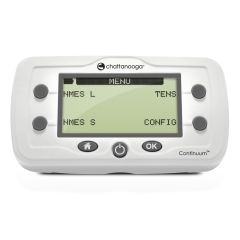Who's Afraid of Electrical Stimulation? Let's Revisit the Application of NMES at the Knee
Elanna K Arhos, Naoaki Ito, Airelle Hunter-Giordano, Thomas P Nolan, Lynn Snyder-Mackler, Karin Grävare Silbernagel
Published in: Journal of Orthopaedic & Sports Physical Therapy, 2024 https://www.jospt.org/doi/10.2519/jospt.2023.12028
This journal article is a commentary to share best practices for using neuromuscular electrical stimulation (NMES) to help restore strength after knee injury.
Quadriceps inhibition is common after knee surgery or knee injury and is a risk-factor for reinjury and developing osteoarthritis.
NMES can be used to help strengthen the quadriceps muscle and is recommended in the 2017 clinical practice guidelines for Knee Stability and Movement Coordination Impairments.
Prior research demonstrates that high-intensity NMES gives the best outcomes, but it is likely that NMES is often used at too low an intensity in the clinic to be effective at restoring optimal muscle recruitment.
The authors recommend the following NMES parameters for effective electrotherapy:
- Pulse width: 400 µs
- Frequency: 50-75 Hz
- Contraction time: 10 s
- Relaxation time: 50 s
- Ramp: 2 s
- Dosed to passively create at least 50% of the patient’s one-rep maximum. No active contraction should be combined to produce this force output.
- Electrodes should be at least 3" x 5" for patient comfort.
The authors evaluated 5 different NMES devices to determine which ones could deliver the recommended parameters. The Chattanooga® ContinuumTM device was the only electrical stimulator tested that could meet all the recommended parameters and achieve a therapeutic dose in 4 out of 5 healthy volunteers.
Studies have shown that neuromuscular deficits can linger for months if quadricep inhibition is not appropriately addressed. Therefore, the authors conclude that using NMES to strengthen the quadriceps muscle is critical to improving outcomes after knee injury, and that NMES must be delivered using effective parameters which includes working with patients to achieve a maximally tolerated dose.

